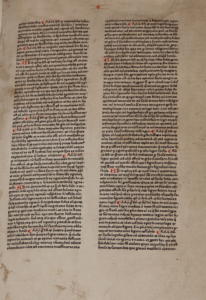
CLZ 742: Thomas de Aquino, Super quarto Sententiarum Petri Lombardi (Mainz, Schoeffer, 1469) is the oldest printed book in the Librije.
The original collection and later additions
De Librije owns a total of 8 manuscripts and 821 printed works. In addition to the books that were present from the beginning, others have been added over time through purchases, donations and bequests. But several books have also disappeared. This can be deduced from the various catalogs and book lists that have been drawn up over the centuries.
The manuscripts date from the fifteenth and sixteenth centuries. The oldest printed work dates from 1469, the last printed work appeared in 1817. A special part are the 87 incunabula – books printed before 1501.
Content
The largest part of the collection consists of theological literature (32%). In addition, a striking number of legal works are present (30%). History is represented at 12%, linguistics and literature at 7%. Also surprising is the number of school books, including several unique copies (12%).







